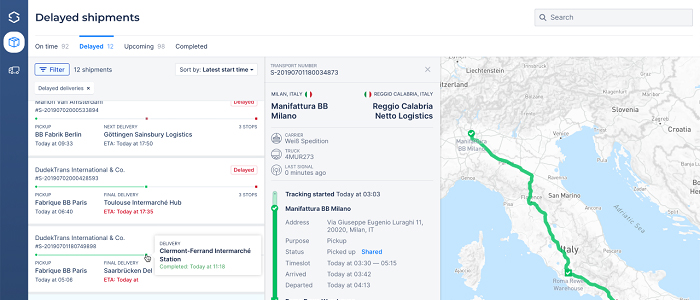-
ROSSLARE EUROPORT TARGETS HEALTH & SAFETY WITH CAMERA TELEMATICS PARTNERSHIP - 2 days ago
-
Landmark Study Reveals Wearable Robotics Significantly Boost Safety and Efficiency in Industrial Environments - July 24, 2024
-
Visku Tackle The Retail Seasonality Challenge One Pallet At A Time - July 22, 2024
-
KAMMAC AND BERGEN LOGISTICS STRENGTHEN FASHION & LIFESTYLE SERVICES IN THE UK - July 19, 2024
-
TENTBOX EXTENDS PARTNERSHIP WITH ARROWXL TO SUPPORT INCREASING DEMAND - July 17, 2024
-
The Perfume Shop improves customer journeys while driving profitability in partnership with Scurri - July 17, 2024
-
ZEROMISSION SECURES £2.3M ($3M) INVESTMENT TO ACCELERATE ELECTRIC FLEETS - July 16, 2024
-
BCMPA CELEBRATES SUCCESS OF 2024 CONFERENCE - July 15, 2024
-
Best of the Best: Jungheinrich Celebrates Triple International Award Win - July 12, 2024
-
GOPLASTICPALLETS.COM CALLS ON NEW CHANCELLOR RACHEL REEVES TO CONSIDER PLASTIC PACKAGING TAX REFORM - July 10, 2024
Visibility of Heavy-Duty Shipments is Central to Sustainability Initiatives
Sixfold issues six solutions for cutting CO2 emissions in transportation
Climate change and the environmental impact of human activity present clear challenges for humanity. New technologies will play a key role in realizing sustainable growth and economic models. Nowadays, many companies are viewing sustainability and greener solutions as giving them a competitive advantage. Sixfold, one of Europe’s leading providers of real-time and predictive logistics visibility, today sets out six solutions on how to reduce CO2 in the transportation sector.
New structure needed for bringing goods into cities
In Europe, much legislation is being written to protect inner cities from big polluting trucks. Companies need to rethink their transportation logistics or soon they will be not allowed to drive into cities. They will have to cross-dock their goods somewhere in the suburbs. There is a need for a new structure on how to bring goods into the city and most likely this will happen with small sprinter electric vans. The new structure needs also a state-of-the-art distribution solution and with the help of a real-time visibility platform, warehouse managers can achieve up to 30% productivity gains according to Sixfold and serious reductions in carbon emissions of trucks waiting to be unloaded through the applied use of smart logistics and better programming of resources for timely offloading.
Reducing empty kilometers lowers CO2 emissions
According to a report from the international organization Paris Process on Mobility and Climate (PPMC), “truck transports account for about 25% of global transport energy use and in Europe a quarter of containers on the road are empty.” The UK transport industry alone could save over 40 million miles of empty journeys by making better use of spare vehicle capacity. The same applies to Germany’s logistics industry where every fifth run is empty mileage. Thanks to logistics visibility platforms, shippers can identify round-trip opportunities and eliminate empty miles.
Co-loading is more and more interesting for big shippers
There is substantial pressure coming from customers who want to order goods in a very short period. Handling over 30,000 stock (mid-range common number for SKUs handled) keeping units that customers can order until 9 pm and delivering them the next morning is challenging for production companies and wholesalers to organize.
To handle the transportation challenge, they need to do more co-loading which means consolidation of shipments across multiple companies on the same transportation vehicles. For brands, it’s getting more important that transportation of ordered goods is “green” and co-loading could be the solution.
Visibility has become a core part of logistics technology. It plays a complementary function that supports transportation, warehouse, yard and fleet management. Co-loading needs those integrations and visibility.
“Ungreen” logistics is a big problem for shippers
There are many brands that highly appreciate sustainability. One example is Sixfold customer Rockwool in winning the coveted Business Climate Prize at the ZERO Conference last November in Norway by developing new electric melting technology for its Moss factory. This will reduce direct CO2 emissions by 80 percent and production-related waste going to landfill by 95 percent, compared to the conventional melting technology it will replace. Combined with the Sixfold visibility platform, Rockwool has developed a powerful way to fight against climate change.
In the beauty industry, women take very seriously that when they buy cosmetics, they are as green as possible. If they would have any scandal about how “ungreen” their purchase is, manufacturers would have a serious problem in selling their products. Today, shippers lack visibility over their shipments and lack vital data for smarter transport management. They have no knowledge of green transportation planning.
EU monitoring and reporting rules
The EU Council has adopted a regulation on the monitoring and reporting of CO2 emissions as well as fuel consumption of new heavy-duty vehicles. This regulation forms part of the EU’s overall efforts to reduce CO2 emissions and is a step towards a competitive low carbon economy.
The new rules enable transport companies, of which many are small and medium-sized enterprises, to obtain access to standardised information on fuel consumption and to compare different models of lorries, trucks and buses. Coupled with a real-time visibility platform, the register will allow shippers to make well-informed purchasing decisions for the delivery of loads, the routes they take, and when the shipments will arrive. They will be able to reduce their fuel bills which account for more than a quarter of their operating costs. The increased transparency of shipments will encourage truck manufacturers to develop more energy efficient heavy-duty vehicles. Higher fuel efficiency also means lower overall CO2 emissions, thus benefiting the environment.
Visibility reduces waste and emissions
Digital technologies can help the logistics industry to better manage and track resources, improve efficiency, and collaborate on ambitious environmental goals. Importantly, we can also quantify and measure progress. Overall, digital technologies have the potential to enable a 20% reduction of global CO2 emissions by 2030 according to the Global e-Sustainability Initiative.
An emerging solution for transport managers and drivers is real-time predictive visibility of inbound logistics … knowing precisely when a shipment will arrive and if there are delays. Armed with that knowledge, warehouse managers can better plan the use of resources and offloading. And that means trucks with livestock or refrigerated goods are less likely to be stuck in a queue with their carbon-emitting engines ticking over waiting to be unloaded.
Visibility across the end-to-end supply chain has now become the most important supply chain initiative in 2019 according to Gartner because implementing a visibility platform leads to reduced costs, waste and emissions.
About Sixfold
Sixfold is one of Europe’s leading real-time logistics visibility platforms for the supply chain. Shippers and carriers seamlessly integrate their transport management systems with the Sixfold visibility platform to know where their shipments are and when they will arrive with minimal manual work from either of the parties. The platform aggregates data from all telematics systems into one data stream giving true end-to-end visibility of shipments. The Sixfold platform has powerful AI capabilities and singularly predicts delays and provides proactive alerts on any shipment delays. Up to Euros 500 million of goods are monitored by Europe’s supply chains each day using the Sixfold platform enabling customers and shippers to gain business advantage and to better plan operations. Sixfold supports customers in more than 25 European languages and data distributed on its platform is totally secure and GDPR compliant. Visit www.sixfold.com.

































